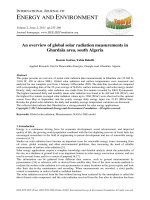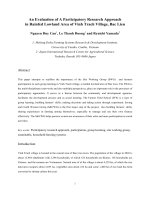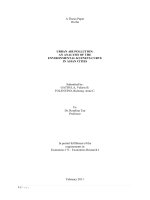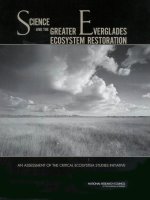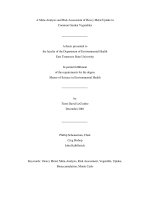An assessment of some heavy metal elements in crude oil
Bạn đang xem bản rút gọn của tài liệu. Xem và tải ngay bản đầy đủ của tài liệu tại đây (325.87 KB, 6 trang )
International Journal of Engineering Science Invention
ISSN (Online): 2319 – 6734, ISSN (Print): 2319 – 6726
www.ijesi.org Volume 2 Issue 11ǁ November 2013 ǁ PP.37-42
www.ijesi.org 37 | Page
An Assessment of Some Heavy Metal Elements in Crude Oil
Contaminated Soils Remediated By Some Wild-Type Legumes
1,
Michael Uche Osam ,
2,
Matthew Owhondah Wegwu And
3,
Edward O. Ayalogu
1,2,3,
Department of Biochemistry, University of Port Harcourt, Choba, Port Harcourt, Nigeria
ABSTRACT: The efficacy of the three wild-type legumes, miracle tree (Leucaena leucocephala), yellow flame
tree (Peltophorum pterocarpum), and rattle weed (Crotalaria retusa), in the remediation of agricultural soils
contaminated with 1% (lightly impacted), 3% (moderately impacted), and 5% (heavily impacted) crude-oil was
assessed, using the soil physicochemical parameters of heavy metallic elements as evaluation criteria. Results
after a 15-month remediation period showed that only L. leucocephala failed to germinate. The levels of all the
heavy metals investigated, namely: copper, Cu (49%), lead, Pb (77%), cadmium, Cd (75%), iron, Fe (68%) and
zinc, Zn (65%) were significantly (p˂0.05) reduced, in both the P. pterocarpum and C. retusa-remediated soil
samples, relative to their respective contaminated samples. These results indicate that L. leucocephala ‘may’
not be a good remediating legume, while both P. pterocarpum and C. retusa are good remediating legumes for
crude-oil impacted soils.
KEYWORDS: Crotalaria retusa, Crude oil, Heavy metals, Leucaena leucocephala, Peltophorum
pterocarpum, Remediation, Wild-type legumes,
I. INTRODUCTION
Trace metals are metals occurring at 1000mg/kg or less in the earth‟s crust [1]. Such metals may be
classified as „heavy‟ or „light‟ with respect to density. Trace „heavy‟ metals have densities greater than 5gcm-
3
(e.g. vanadium) whereas „light‟ metals have densities less than 5gcm-
3
(e.g. beryllium). Trace heavy metals are
in turn classified as nutrient and non-nutrient heavy metals, according to their nutritional and biochemical
significance [2]. Cadmium and lead are designated as non-nutrient trace-elements, as they have no known
function in humans. These metals are known to be toxic even at very low levels of intake, and present no
identified deficiency symptoms. Excessive amounts of trace heavy metals (as well as trace light metals) may
occur in the biosphere as a result of normal geological phenomena such as ore formation, weathering of rocks,
and leaching or degassing (in the case of mercury). Other activities that could contribute to excessive release of
these metals into the environment include burning of fossil fuels, smelting and discharges of industrial,
agricultural, and domestic wastes as well as deliberate application of pesticides. Anthropogenic contributions or
human activities such as petroleum prospecting and mining as well as oil spillages are also major sources of
these metals [3].
The ecological significance of heavy metals, in recent times, is traceable to the growing awareness of their
accumulative characteristics and toxicity [4]. These inorganic ions are generally non-biodegradable and
undergo an ecobiological cycle. The peculiarity of heavy metals lies in their ability to accumulate unnoticed to
toxic levels [5]. This, of course, is distinct from other pollutants such as petroleum hydrocarbons and litter,
which may visibly build up in the environment. The toxicological action of cadmium has been attributed to its
chemical similarity with zinc, as cadmium may conveniently replace zinc in some enzymes, thus altering their
three–dimensional structure and impairing catalytic activity [6].
The soil is very important to human existence for various reasons especially agriculture. However, the soil has
been subjected to several abuses including spillage of petroleum (crude oil) and petroleum-by products,
dumping of wastes and other contaminating activities [7] [8] [9] [10].
When oil spills on-shore, the soil ecosystem is usually inundated, leading to several conflagrations that may
consume several acres of arable land, which is the prime factor in agricultural productivity. Today,
environmental managers can choose from a variety of approaches to remediate petroleum-contaminated soil and
groundwater. The approach or approaches chosen in such clean-ups had been those orthodox expensive and
ineffective conventional practices, (e.g. „pump-and-treat‟ and „dig-and-dump‟ techniques), which are not
environmentally friendly (as they merely transfer the pollutants from one site to another).
An Assessment Of Some Heavy Metal…
www.ijesi.org 38 | Page
An environmentally sound technology (EST) that addresses the inadequacies of these old remediation practices
will therefore be pertinent in this era of global economic melt down. Here comes the natural clean-up method,
„phytoremediation‟ – the technology that utilizes the inherent abilities of living plants for the removal,
degradation, or containment of contaminants in soils, sludge, sediments, surface water and ground water. The
technology is ecologically friendly, solar-energy driven, and is based on the concept of using “nature to cleanse
nature”.
Phytoremediation technology has been proved to be a successful method of treating contaminated soils to levels
below the maximum permissible level of the contaminants. For instance, Simeonova and Simeonov [11],
successfully phytoremediated a three-kilometer ecological zone contaminated with lead, using Brassica juncea
plants. The results of their one-planting experiment showed a decrease between 0 and 25.9% of the initial lead
concentration at various sample locations.
It is against this background, predicated by the plethora of unsuccessful, environmentally-unfriendly and
expensive conventional remediation methods that we were prompted to investigate the effectiveness and
efficacy of some wild-type legumes commonly found growing luxuriantly on crude oil impacted soils in the
Niger Delta Region of Nigeria, in remediating/reducing the level of petroleum hydrocarbon-contaminated
agricultural soils to at least the maximum permissible level, and thus minimize the impact of oil spill on
agricultural productivity
II. MATERIALS AND METHODS
2.1. MATERIALS
In addition to the laboratory reagents, the following chemicals and biochemicals were used for the
work: Forty litres of crude oil (obtained from Nigerian Agip Oil Company, NAOC, Ebocha, Rivers State), over
200 seeds of each of the legumes:
(1) Yellow flame tree, Peltophorum pterocarpum (figure 1). This was obtained from the Convocation arena of
the University of Port Harcourt, Nigeria.
Figure 1: YELLOW FLAME TREE (Peltophorum pterocarpum)
(2) Miracle tree, Leucaena leucocephala (figure 2). This was obtained from the International Institute of
Tropical Agriculture, IITA. Eneka, Rivers State.
Figure 2: MIRACLE TREE (Leucaena leucocephala)
An Assessment Of Some Heavy Metal…
www.ijesi.org 39 | Page
(3) Rattle weed, Crotalaria retusa (figure 3). This was obtained from Bayelsa State, Nigeria.
Figure 3: RATTLE WEED (Crotalaria retusa)
These legumes were identified, classified and authenticated as being of high quality by the Department of Plant
Anatomy and Physiology, University of Port Harcourt, Nigeria.
2.2 METHODS
2.2.1 Land mapping/preparation
Ten widely-spaced plots (measuring 12 x 10 ft each) and labelled E
1,
E
2,
…E
9,
the 10
th
plot which is the
control, - is a non-vegetative geographically virgin area similar to the experimental plots, but unaffected by oil
spill and located at a distance of about 2 km from the experimental plots. Preliminary preparation of the
seedbeds was undertaken so as to remove any rubbles that would interfere with agronomic practices, e.g. weeds,
grasses and little trees were removed to facilitate seedbed preparation. Tilling of the soil was performed to about
8-11cm depth.
2.2.2 Contamination of the plots
Contamination of the plots were done as follow: plots E
1
- E
3
(1-EQ), were uniformly poured 1% by
weight of concentration of crude oil at a total quantity of 30 litres per plot as reported by Thoma et al, [16],
and modified similarly by the researcher. This was similarly done for plots E
4
- E
6
(3-EQ), and E
7
- E
9
(5-EQ) but
with 3% and 5% by weight of the crude oil respectively. Contaminated samples were collected 7 days after the
contamination.
2.2.3 Planting of the wild-type legumes
Planting of the wild-type legumes was done 14 days after contamination using 20 seeds per plot. The
target population was to obtain between 10 and 15 plants per m
2
, as reported by Simeonova and Simeonov [11],
for Brassica juncea planted in lead-contaminated ecological zone.
2.2.4 Sampling techniques
Triplicate soil samples were collected randomly from three spots at 2 core depths of top surface (0-
15cm) and sub-surface (15-30cm), using a long trowel. Post-remediation sampling was 15 months later after
removing the legumes. A total of 60 samples, made up of: 6 control samples (2 per spot, i.e. top and sub
surface); 18 contaminated samples (6 for each of the plots contaminated with 1%, 3%, 5% crude oil, and finally
36 post-remediated samples (6 for each of the three plots remediated with P. pterocarpum, and C. retusa). No
soil samples were collected from the 3 plots planted L. leucocephala since the plant failed to germinate. The soil
samples were wrapped in aluminium foil and labelled accordingly before being sent to the laboratory for the
various analyses
2.2.5 Determination of concentration of trace heavy metals
The concentration of the trace heavy metals: Cd, Pb, Fe, Cu and Zn in the soil samples was determined
by the atomic absorption spectrophotometric (AAS) technique from the acid digests as reported by Osam et al,
[17].
An Assessment Of Some Heavy Metal…
www.ijesi.org 40 | Page
2.2.6 Method of data analysis
The data were analyzed using tables, range, means, percentages, graphs (bar charts), standard deviation
and hence standard error (SE). Sample mean was calculated for all the three replicate samples, while standard
deviation (S.D) was calculated from the sample mean by the standard statistical method for all the variables.
The standard deviations were used to calculate the standard errors (±S.E) as reported by Osuji et al, [18].
Standard error (±S.E) was estimated at the 95% confidence level by multiplying the standard error with 1.96.
Also, all the data obtained were subjected to statistical analysis of variance (ANOVA) technique using
computer-aided SPSS statistical programme, and the means separated and compared using Duncan‟s Multiple
Range test [19] at 5% level of significance.
III. RESULTS
The seeds of miracle tree (Leucaena leucocephala), failed to germinate in all the three quadrats that
they were planted. The result of the trace heavy metals, iron, zinc, cadmium and copper are shown in tables 1, 2,
3, 4 and 5 respectively, below:
TABLE 1: MEAN (±S.E
a
) IRON, Fe CONC
b
, (mg/kg) OF REMEDIATED SOIL SAMPLES
REMEDIATED BY
SAMPLE
DEPTH
CONTROL
CONTAMINATED
P. pterocarpum
C. retusa
LOCATION
(cm)
1-EQ
0 – 15
5576 ± 2.40
6249 ± 3.00
2710 ± 3.00
2289 ± 1.40
1-EQ
15 – 30
4746 ± 5.60
5645 ± 4.90
3116 ± 3.50
3205 ± 4.90
3-EQ
0 – 15
5576 ± 2.40
7041 ± 3.00
2156 ± 6.00
2828 ± 4.90
3-EQ
15 – 30
4746 ± 5.60
6799 ± 0.80
2820 ± 3.90
3031 ± 1.60
5-EQ
0 – 15
5576 ± 2.40
7779 ± 3.00
2096 ± 5.60
1203 ± 2.30
5-EQ
15 – 30
4746 ± 5.60
7697 ± 2.30
2908 ± 2.40
2300 ± 1.40
a
S.E: Standard error at 95% confidence level
b
CONC: Concentration
TABLE 2: MEAN (±S.E
a
) ZINC, Zn CONC
b
, (mg/kg) OF REMEDIATED SOIL SAMPLES
REMEDIATED BY
SAMPLE
DEPTH
CONTROL
CONTAMINATED
P. pterocarpum
C. retusa
LOCATION
(cm)
1-EQ
0 – 15
5.00 ± 0.079
10.43 ± 0.023
4.43 ± 0.040
6.27 ± 0.023
1-EQ
15 – 30
4.40 ± 0.080
10.20 ± 0
2.14 ± 0.040
2.66 ± 0.049
3-EQ
0 – 15
5.00 ± 0.079
11.50 ± 0.023
6.80 ± 0.008
5.62 ± 0.043
3-EQ
15 – 30
4.40 ± 0.080
10.70 ± 0.040
2.01 ± 0.020
2.25 ± 0.011
5-EQ
0 – 15
5.00 ± 0.079
11.70 ± 0.020
5.22 ± 0.030
4.57 ± 0.024
5-EQ
15 – 30
4.40 ± 0.080
11.67 ± 0.014
2.50 ± 0
2.05 ± 0.049
a
S.E: Standard error at 95% confidence level
b
CONC: Concentration
TABLE 3: MEAN (±S.E
a
) CADMIUM, Cd CONC
b
, (mg/kg) OF REMEDIATED SOIL SAMPLES
REMEDIATED BY
SAMPLE
DEPTH
CONTROL
CONTAMINATED
P. pterocarpum
C. retusa
LOCATION
(cm)
1-EQ
0 – 15
0.10 ± 0
0.13 ± 0.034
0.018 ± 0.004
0.090 ± 0.020
1-EQ
15 – 30
0.06 ± 0.011
0.12 ± 0.008
0.050 ± 0.011
0.017 ± 0.004
3-EQ
0 – 15
0.10 ± 0
0.20 ± 0.023
0.012 ± 0.011
0.110 ± 0.008
3-EQ
15 – 30
0.06 ± 0.011
0.20 ± 0.030
0.030 ± 0
0.100 ± 0.018
5-EQ
0 – 15
0.10 ± 0
0.33 ± 0.079
0.060 ± 0.030
0.020 ± 0.008
5-EQ
15 – 30
0.06 ± 0.011
0.24 ± 0.020
0.020 ± 0.018
0.050 ± 0
a
S.E: Standard error at 95% confidence level
b
CONC: Concentration
An Assessment Of Some Heavy Metal…
www.ijesi.org 41 | Page
TABLE 4: MEAN (±S.E
a
) COPPER, Cu CONC
b
, (mg/kg) OF REMEDIATED SOIL SAMPLES
REMEDIATED BY
SAMPLE
DEPTH
CONTROL
CONTAMINATED
P. pterocarpum
C. retusa
LOCATION
(cm)
1-EQ
0 – 15
2.02 ± 0.023
2.37 ± 0.030
1.77 ± 0.008
1.42 ± 0.024
1-EQ
15 – 30
1.80 ± 0.034
2.21 ± 0.030
1.35 ± 0
1.37 ± 0.024
3-EQ
0 – 15
2.02 ± 0.023
2.60 ± 0.029
1.45 ± 0.034
1.60 ± 0.008
3-EQ
15 – 30
1.80 ± 0.034
2.42 ± 0.023
0.99 ± 0.011
1.58 ± 0.023
5-EQ
0 – 15
2.02 ± 0.023
2.85 ± 0.018
1.08 ± 0.023
1.22 ± 0.020
5-EQ
15 – 30
1.80 ± 0.034
2.60 ± 0
1.07 ± 0.011
0.91 ± 0.014
a
S.E: Standard error at 95% confidence level
b
CONC: Concentration
TABLE 5: MEAN (±S.E
a
) LEAD, Pb CONC
b
, (mg/kg) OF REMEDIATED SOIL SAMPLES
REMEDIATED BY
SAMPLE
DEPTH
CONTROL
CONTAMINATED
P. pterocarpum
C. retusa
LOCATION
(cm)
1-EQ
0 – 15
0.44 ± 0.043
1.80 ± 0.008
0.49 ± 0.014
0.52 ± 0.024
1-EQ
15 – 30
0.22 ± 0.008
1.47 ± 0.030
0.46 ± 0.030
0.51 ± 0
3-EQ
0 – 15
0.44 ± 0.043
2.95 ± 0.020
0.52 ± 0
0.77 ± 0.040
3-EQ
15 – 30
0.22 ± 0.008
2.70 ± 0.014
0.50 ± 0.027
0.71 ± 0.018
5-EQ
0 – 15
0.44 ± 0.043
3.35 ±0.023
0.77 ± 0.052
0.90 ± 0.023
5-EQ
15 – 30
0.22 ± 0.008
3.10 ± 0.020
0.72 ± 0.030
0.86 ± 0.011
a
S.E: Standard error at 95% confidence level
b
CONC: Concentration
IV. DISCUSSIONS
Trace heavy metals such as Fe, Cu, Pb, Mn and Zn are among the 16 essential elements required by
plants, though needed in only very small quantities. They may also inhibit microbial metabolism in high
amounts. The result of all the heavy metals measured in the contaminated soils shows that the mean range of Fe
for the both surface soils was 5645±4.9-7779±3.0mg/kg, while for the soils remediated with P. pterocarpum
was 316±3.6-2908±2.4mg/kg and for those remediated with C. retusa was 1203±2.3-3205±4.9mg/kg. This
reveals the outrageously high value of Fe, higher than the acceptable limit of 100mg/kg for both the
contaminated and remediated soils. The rest of the metals measured were very low and within the ambit of
acceptability. Naturally, soils at various locations have a trace amount of heavy metals even in undisturbed
environments. Enhanced concentrations of metals like Fe, Cd, Cu, Pb and Zn in the soils may result to enhanced
absorption by plants. Possible bioaccumulation may occur, which may lead to toxic reactions along the food
chain [20]. The values obtained for the heavy metals in this study compared favourably with the findings of
past workers like Wegwu and Onyeike [14]. However, the high values of Fe measured though significantly
(p˂0.05) remediated (48% by P. pterocarpum and 46% by C. retusa), were still far beyond the acceptable limit
of 100mg/kg, a second planting of the legumes will be imperative to lower the concentration of Fe in the soils.
Several other workers like Nwaugo et al, [21] had also measured high Fe concentrations in abandoned mine pits,
as well as Akubugwo et al [22], who posited that the high Fe content may be due to the reduction of Fe
3+
to Fe
2+
as a result of favourable reducing conditions provided by the oil pollution. Such high concentrations of Fe
2+
in
the soil may render the soil toxic for plant growth, hence an overall pollution. The high percentage reduction
observed in the remediated oils relative to the contaminated, especially for Fe by both legumes lucidly attests to
the ability of the plants in containment of the toxic substances.
Several studies serve as examples of the rhizosphere effect in the phytoremediation of organic contaminants.
Gunther et al, [23] suggested that plant roots stimulated the microbes, which enhanced the degradation of the
hydrocarbon mixture.
An Assessment Of Some Heavy Metal…
www.ijesi.org 42 | Page
V. CONCLUSION
The above results clearly attest to the fact that Leucaena leucocephala „may‟ not be good petroleum
hydrocarbon-remediating plant since it failed to germinate in the crude oil impacted soils. Out of the five heavy
metals (or soil quality indicators) used to assess the efficacy of the legumes, Peltophorum pterocarpum and
Crotalaria retusa, both legumes significantly (p˂0.05) reduced the levels of the five heavy metals whose
concentrations were elevated. These imply that both legumes are good phytoremediators of crude-oil
contaminated soils.
REFERENCES
[1] J. H. Duffus,. (1980). „Environmental Toxicology‟. Edward Arnold Publishers Limited, London. Pp. 21-103.
[2] M. O. Wegwu and I. A. Wigwe (2006). Trace-metal contamination of the African Giant Land snail (Archachatina marginata) from
Southern Nigeria. Chemistry and Biodiversity. 3:88-93.
[3] L. C. Osuji and C. M. Onojake (2004). Trace Heavy Metals Associated with crude oil: A case study of Ebocha-8 oil-spill-polluted
site in Niger Delta, Nigeria. Chemistry and Biodiversity, 1: 1708-1715.
[4] D. Purves (1985). „Trace Element Contamination of the Environment‟ Elsevier, Amsterdam.
[5] M. O. Wegwu and J. O. Akaninwor (2006). Assessment of Heavy-metal Profile of the New Calabar River and its Impact on
Juvenile Cliarias gariepinus. Chemistry and Biodiversity. 3:79-87.
[6] M. O. Wegwu (1999). Seasonal variations of pollutants in some areas of the Niger Delta and their toxicity on some aquatic fauna.
Ph.D Dissertation, Biochemistry Department. University of Port Harcourt, Nigeria. Pp. 197-228.
[7] M. U. Osam. (2011). Evaluation of the efficacy of selected wild-type legumes in the remediation of crude oil contaminated
Agricultural soils. PhD Dissertation, Biochemistry Department, University of Port Harcourt, Nigeria.
[8] V. O. Nwaugo; R. A. Onyeagba; N. Azu and N. C. Nwachukwu. (2006) Bacteriological quality of cercariae (Schistosoma
haematobium) infested abandoned quarry pits water. J. Sc. Engr. Tech. 13(2):6697–6706.
[9] V. O. Nwaugo; S. O. Obiekezie and C. A. Etok. (2007). Post-operational effects of heavy metal mining on soil quality in Ishiagu,
Ebonyi State. Int. J. Biotechnol and Allied Sci. 2 (3): 242-246.
[10] B. Wellingia; J. R. Lucy; J. N. Moore; O. Seastone and J. E. Gamen, (1999). Microbiological and geochemical characterization of
alluvially deposited sulphide mine tailings. Appl. Environ. Microbiol. 65: 1548 – 1555.
[11] B. G. Simeonova and L. I. Simeonov (2006). An application of phytoremediation technology in Bulgaria. The kremitovtzi steel
works experiment. Journal of Environmental Clean-up costs, technologies and techniques. 16 (2): 113-123
[12] United States Environment Protection Agency, USEPA (2002). Mid-Atlantic Integrated Assessment (MAIA) Estuaries 1997-98:
Summary Report, EPA/620/R-02/003, 115 pp.
[13] World Health Organization, WHO (1997). „Environmental Health Criteria‟. Geneva. P. 160.
[14] M. O. Wegwu and E. N. Onyeike (2006). Growth Performance and Proximate profile of Telfairia occidentalis Hook F.
(Cucurbitaceae) grown in crude oil-contaminated soil. Journal of Environmental Clean-up Costs, Technologies and Techniques.
16(2):99-111.
[15] L. C. Osuji and S. O. Adesiyan (2005). The Isiokpo oil-pipeline leakage: Total organic carbon/organic matter contents of affected
soils. Chemistry and Biodiversity. 2: 1079-1085.
[16] G. Thoma; D. Wolf and S. Ziegle (2002). Using Plants to Remediate Petroleum-Contaminated Soil-Project. Continuation Annual
Report. (Retrieved, 30/07/2008).
[17] M. U. Osam; M. O. Wegwu and A. A. Uwakwe. (2008) Post-Impact Assessment of soils polluted by oil spillage in Omoku, Rivers
State. Journal of Nigerian Environmental Society. 4 (4): 27-38.
[18] L. C. Osuji; E. J. Egbuson and C. M. Ojinnaka (2005). Chemical reclamation of crude-oil inundated soils from Niger Delta, Nigeria.
Chemistry and Ecology. 21 (1): 1-10.
[19] D. B. Duncan. (1955). Multiple Range and multiple F. Tests. Biometrics. 11:1- 42.
[20] L. C. Osuji; I. D. Idung and C. M. Ojinnaka (2006). Preliminary investigation on Mgbede -20 oil-pollution site in Niger Delta,
Nigeria. Chemistry and Biodiversity. 3: 568-577.
[21] V. O. Nwaugo; I. S. Onwuchekwa; C. Ogbonna and R. A. Onyeagba. (2009). Assessment of physicochemical and Biological
indices of fluvial Deposits in Abandoned Mine Pits in Ishiagu, South Eastern Nigeria. Nigerian Journal of Microbiology. 23 (1):
1830-1838.
[22] E. I. Akubugwo; G. C. Ogbuji; C. G. Chinyere; and E. A. Ugbogu, E. A. (2009). Physicochemical Properties and Enzyme activity
studies in a refined oil contaminated soil in Isikwuato, Abia State, Nigeria. Biokemistri 21(2): 79-84.
(Retrieved 10/07/10).
[23] T. Gunther; U. Dornberger and W. Fritsche. (1996). Effects of ryegrass on biodegradation of hydrocarbons in soil. Chemosphere.
33 (2): 203-215.

